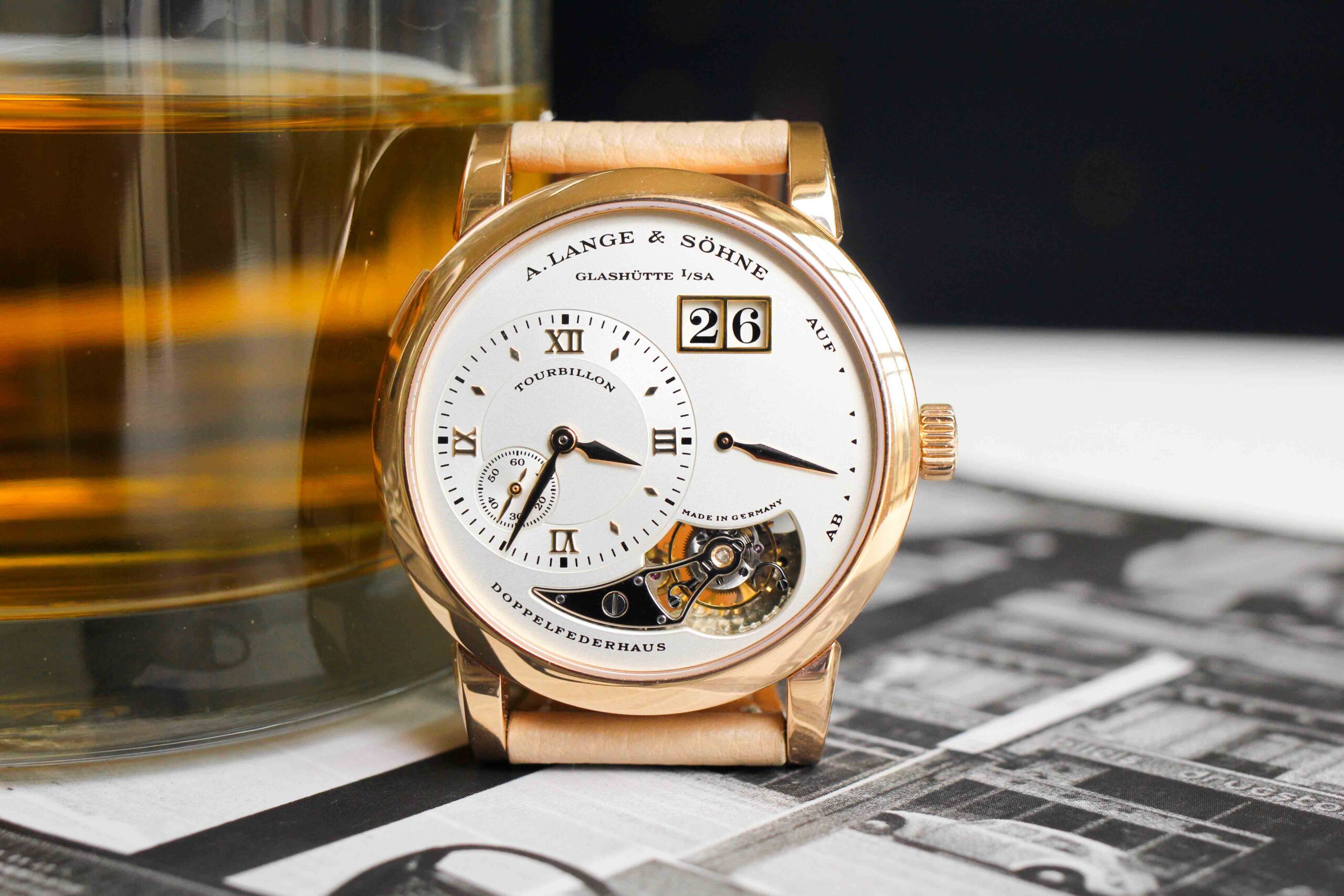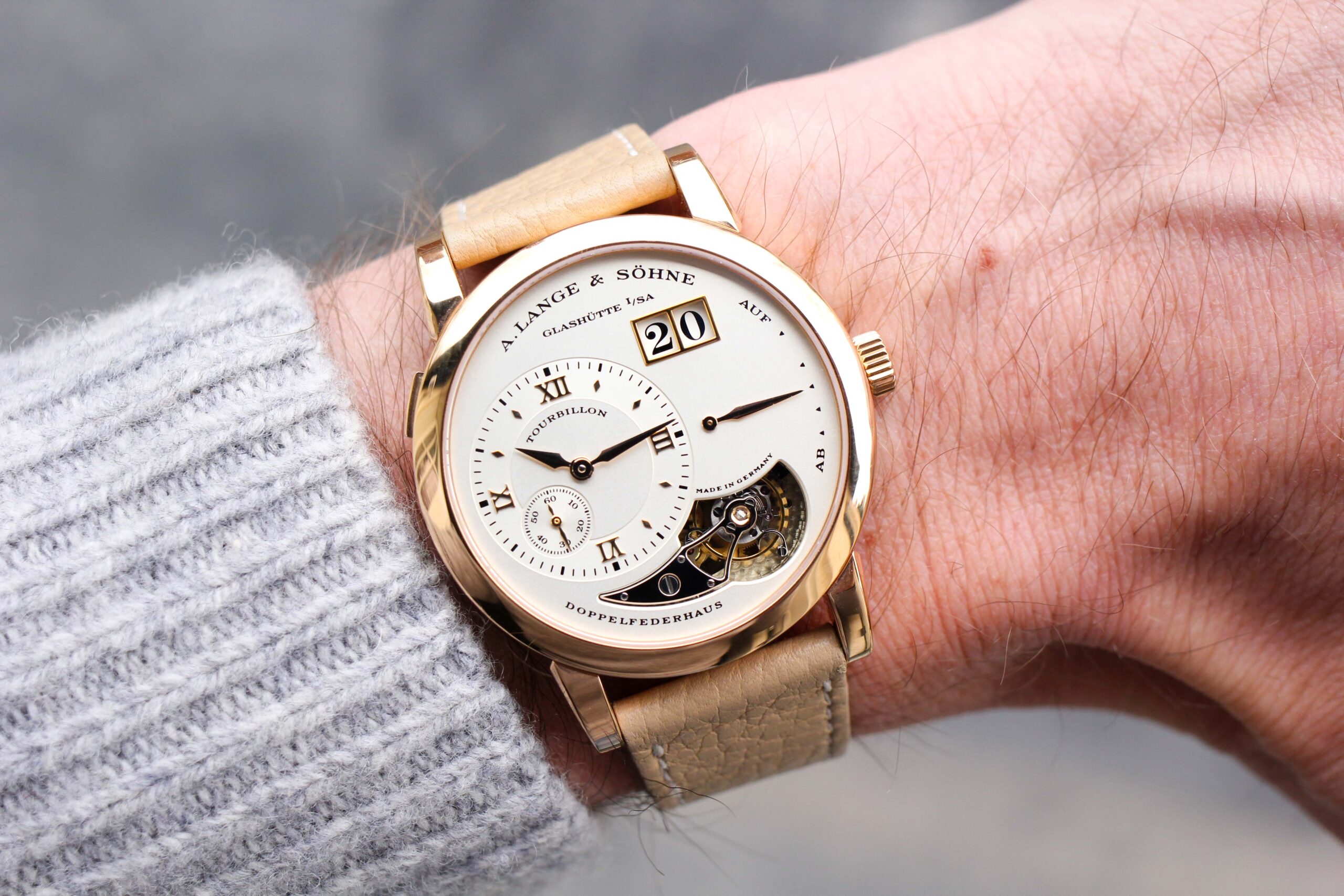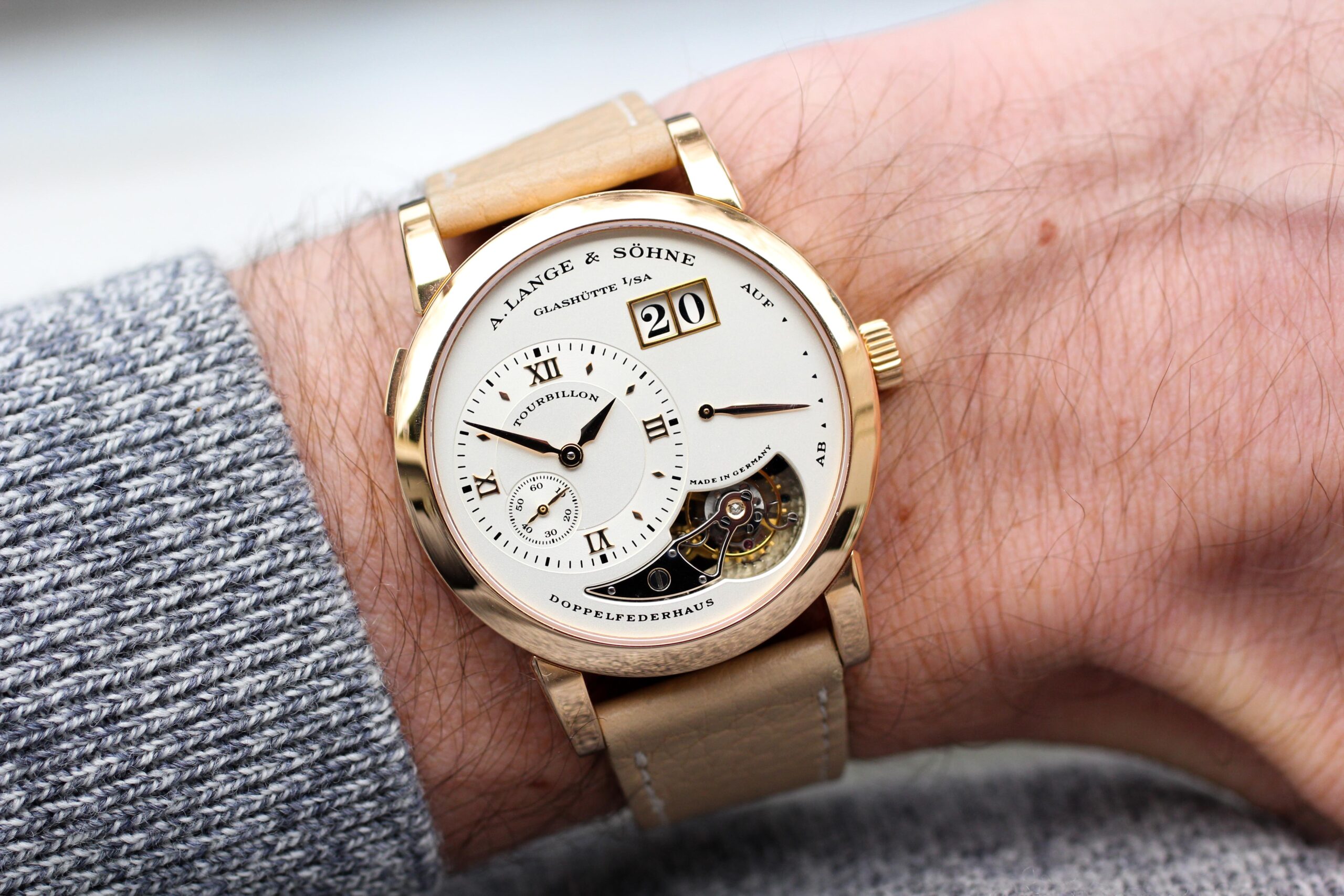The Lange 1 tourbillon is a polarizing watch among Lange diehards. For some collectors, it is a fascinating and distinctive early reference of one of the most iconic watches ever produced. For others, the Lange 1 tourbillon is a lightning rod that cast aside the pure aesthetics of the original design with mixed results.
As discussed later, the Lange 1’s design – though seemingly staid at first glance – was painstakingly exact and cohesive. As such, the implementation of a tourbillon within the Lange 1 design was an unconventional decision at the time. Before digging deeper into the history behind the reference 704.032, however, it is worth providing context on the brand and the Lange 1 lineage.
Understanding The Brand
A. Lange & Sohne (which I will often refer to as “Lange” throughout this article) is known as one of the most prolific and high-end watch manufacturers today, but not all collectors are aware of the brand’s turbulent history. There have been many deep dive articles on the history of Lange (such as this terrific post by A Collected Man), but I will quickly summarize it because, well, you’re already here, and it’s a critical piece of the Lange 1’s story.
Lange was founded by Ferdinand Adolph Lange in 1845 under the name of A. Lange & Cie. Ferdinand chose Glashütte, a depressed town with no prior history of watchmaking, as the home for his fledgling brand. He initially began with 15 apprentices, who were schooled in his vision of modern watchmaking and were eventually encouraged to leave and start their own specialized manufacturing companies, which supplied key watchmaking parts for Ferdinand and others. As it were, Ferdinand Lange not only founded A. Lange & Sohne, but also established Glashütte as the epicenter of German horology for centuries to come.
Over the next 70 years, the brand continued to evolve and gained notoriety for its proficiency in chronometers and complex pocket watches. Unfortunately, however, this was to serve as the peak for the initial iteration of the brand. World War I and the subsequent Great Depression of 1929 significantly curtailed demand for Lange’s products, leading to layoffs and supply chain difficulties.
The following decade saw a strong increase in production, though it was unfortunately linked to Germany’s large-scale efforts at rebuilding its armed forces under Adolf Hitler, as Lange was one of five German watchmakers contracted to build oversized pilots’ watches for Germany’s air force, the Luftwaffe. World War II would eventually bring about the end of Lange’s “first life,” as the manufacturing facility was significantly damaged by a Soviet air raid on May 8, 1945 – cruelly, the final day of the war in Europe, as Germany formally surrendered the following day.

A. Lange & Sohne’s factory, which was heavily damaged on the final day of World War II
Following the end of World War II, Saxony was formally occupied by the Soviet Union, and in 1948, all of the watchmaking companies in Glashütte were nationalized. In 1951, the seized companies were eventually all merged into one entity (“VEB Glashütter Uhrenbetriebe”), marking the end of A. Lange & Sohne as it had previously existed. It was not until the Soviet Union collapsed in 1988 that the great-grandson of Ferdinand Adolph Lange (Walter), in collaboration with watch industry veteran Günter Blümlein, began to envision a revival of his family’s legacy.
Understanding The Lange 1’s Design
A. Lange & Sohne was officially re-launched on December 7, 1990, which was exactly 145 years after its original founding. It would take four years, but in 1994, the brand was ready to unveil its first consumer-facing references in nearly 60 years. The first four models (the Arkade, Saxonia, Tourbillon Pour le Mérite, and Lange 1) featured a common design aesthetic, but different case sizes, dial layouts, and complications. Production was very low – 123 examples across all four references – and they were distributed evenly amongst 12 retailers in Switzerland and Germany. The brand’s reintroduction was a quick success, with the Lange 1 becoming the most sought after and important model.

Günter Blümlein, Walter Lange, and Hartmut Knothe next to the brand’s four initial models in 1994
As Jon Bues wrote in Hodinkee’s Reference Points on the Lange 1, “it’s difficult to think of a single watch design that has done more to advance the cause of a modern brand than A. Lange & Sohne’s Lange 1 – and based on its symbolic name, it’s fair to say that…Lange…conceived the model to be the foundation of the brand from the very beginning.” In the eyes of both Lange and collectors, the Lange 1 isn’t just the most visible creation of the brand…it IS the brand. And much of that association and importance is due to the brilliance of the design itself.
Upon thoughtful inspection, the Lange 1 seems to inhabit multiple design languages simultaneously. The applied Roman numerals and typography throughout the dial hearkens back to classic dress or pocket watches, while the deconstructed nature of the dial is more commonly associated with progressive independent watchmaking. The combination of those two design elements should be wholly incompatible, but in the case of the Lange 1, it’s so well executed that I don’t even think of it as a “deconstructed” design while looking at it.
The design holds together and seems perfectly at ease, despite the fact that none of the functions or complications overlap or are laid out in a traditional way. It is abstract but also incredibly cohesive and calculated – as the below graphic from A Collected Man shows, the planes of the four displays are perfectly aligned and distributed across the dial, providing all of the required information and also leaving ample room for negative space.

Illustration courtesy of A Collected Man
In addition to the elegance of the design itself, Lange’s continued focus on the Lange 1 as the brand’s tentpole has yielded a vast selection of collectible references in various dial colors, metals (including an incredibly rare batch of steel Lange 1’s), and additional complications. The reference has been in continuous production since the brand’s re-birth, and likely will remain as such for as long as Lange exists.
The Story Behind My Lange 1 Tourbillon
A. Lange & Sohne was a brand that I had admired from the earliest days of my collecting journey. Interestingly, however, it was not the Lange 1 that was the first Lange I noticed – rather, that honor goes to the Datograph. The Datograph was big, bold, and powered by one of the most stunning movements I’d ever seen. In comparison, the Lange 1 seemed stodgy and a little boring. At the time, Lange 1’s traded well below retail, and for rookie horologists like me, that signaled that they would never be as desirable or important. If Lange 1’s would always be under-appreciated and generally available, why rush to explore them?
In 2018, a friend gave me the opportunity to borrow his yellow gold reference 101.001, the very first Lange 1 reference. Despite its rarity, the 101.001 was almost unknown to casual collectors at the time and traded for ~$20K (a discount to the MSRP of modern Lange 1’s). After wearing and interacting with it for a couple of weeks, I began to understand a bit more about the appeal of the Lange 1, though I didn’t like it enough to rush out and find one for myself immediately.
The watershed moment truly arrived roughly a year later, however, when I grabbed drinks with a friend (@spintransistor) in a dimly lit bar in Chicago’s Loop. He had just purchased the “Darth,” a platinum Lange 1 (reference 101.035) with a black dial and a color matched date wheel. On the wrist, I found it to be one of the most magnificent watches I’d ever worn and it ignited a profound desire to find my own Darth.

The “Darth” Lange 1. Image courtesy of A Collected Man
As often happens, however, life got in the way. My wife was pregnant with our second son and we were contemplating a move out of the city and into a bigger space. As reasonable as Lange 1 prices were, the Darth would have to wait – and why should I rush anyways, it would remain under-appreciated forever, right? Wrong. Very wrong.
Over the next 12 months, Lange began to receive increased attention from collectors and speculators alike. Particularly rare references of the Lange 1 began to increase in value on a weekly basis, and by 2021, a little over a year past the point where I had tried on my friend’s Darth, the going rate for a Darth was ~$50K…an increase of almost 100% since 2019.
My attention soon shifted to other limited references – the 101.027 / 191.028 (blue dials) and the 101.030 (grey dial) – but similar market forces were fast at work. Price appreciation for Lange continued at a fever pitch throughout 2021 and into early-2022, and all of a sudden, Darth and its blue dialed counterparts were changing hands for nearly $80K. I began to browse Chrono24 daily out of contempt rather than desire. “How much are these dumb watches trading for today?” I’d sullenly ask myself, while feeling that I’d missed the boat. But it was on one of these occasions that I mistakenly came to learn about the Lange 1 Tourbillon (reference 704.032).

The Lange 1 Tourbillon was introduced in 2000 to mark the passage of 100 years since the brand’s first tourbillon was introduced in 1900. The reference represented the first new complication to be added to the Lange 1 since its introduction, and the production was quite limited: 150 examples made in platinum (reference 704.025) and 250 examples in rose gold (reference 704.032).

This is an original advertisement for the reference 704.032, which hangs in my office (courtesy of Ad Patina)
The word “tourbillon” can often be used as a synonym for “ostentatious.” Skeletonized dials, large dimensions, overly ornate casework, and eye watering costs of entry are the norm in the world of tourbillons. While those characteristics don’t typically appeal to me, the Lange 1 Tourbillon somehow felt different. The design closely resembles a normal Lange 1 and the case dimensions are virtually identical, with a 38.5mm diameter and 10.2mm height.
There are a few key differences compared to the regular Lange 1, however. To accommodate the addition of the tourbillon, the running seconds subdial was moved inside of the minute/hour display – a decision that was highly controversial within Lange, it should be noted. In its place, a small cutout revealed the spinning tourbillon cage, accentuated with a black polished tourbillon bridge. The German Silver movement features the same 3/4 base plate as other Lange 1’s, but with two intricately engraved balance cocks at the base. Interestingly, the tourbillon also utilizes diamonds rather than rubies for the capstones on the tourbillon staff.
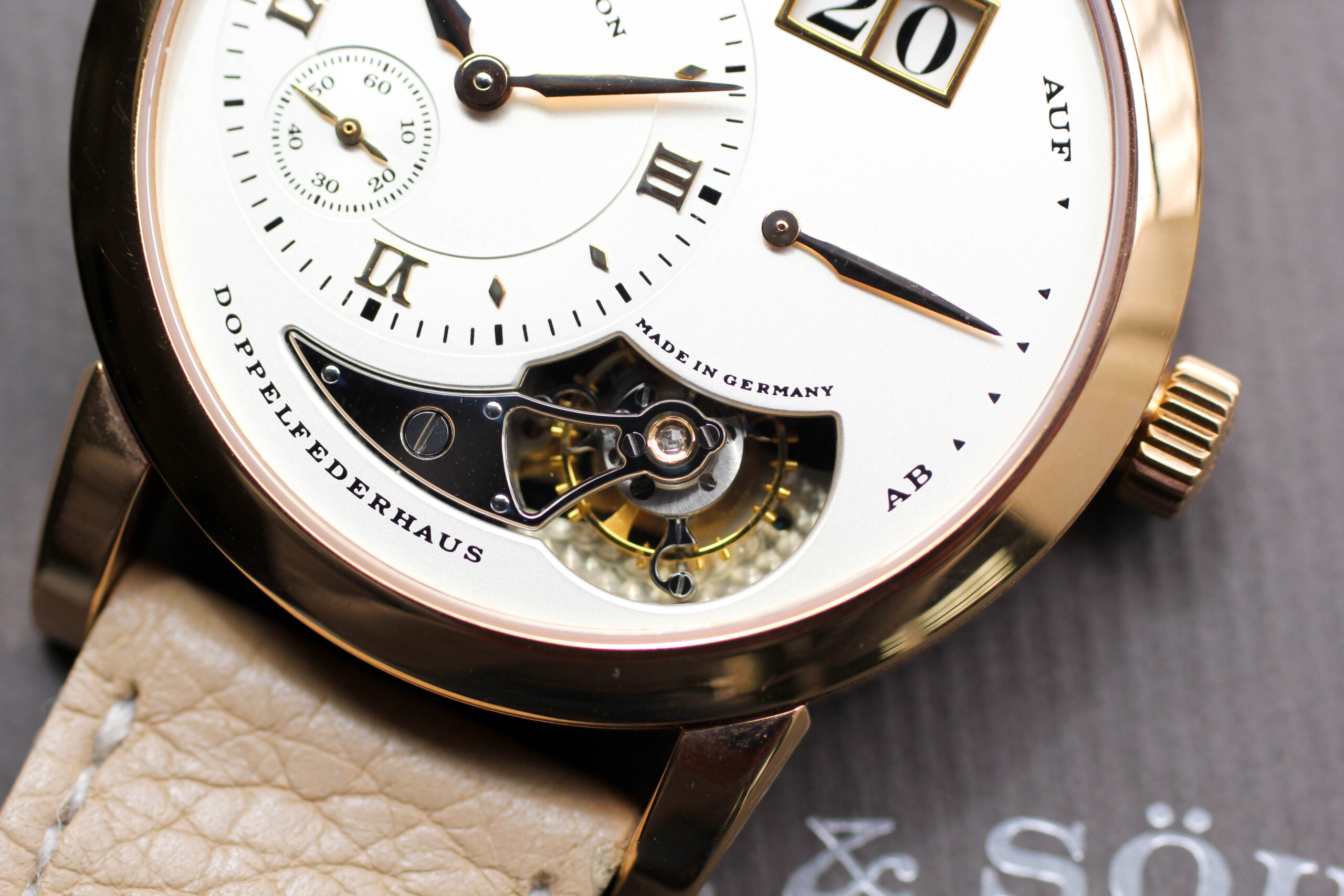
Notice the diamond capstone on the tourbillon staff, rather than a traditional ruby
After learning about the Lange 1 Tourbillon, I soon came across a very reasonably priced example for sale. When I say “reasonable,” mind you, we are still talking about the most expensive watch I’ve ever purchased, but it was priced nearly at parity with Darth, blue dialed Lange 1s, and early 101.001’s…and was the original Lange 1 tourbillon from a limited run of 400 examples! I sanity checked my view with a couple other knowledgeable collectors and within a matter of hours, I committed to purchase the watch. Once unboxed, any potential buyer’s remorse immediately evaporated.
While I was enamored with the brand prior to owning a Lange, my purchase of the Lange 1 tourbillon (and subsequently the 1815 Chronograph) has cemented my belief that A. Lange & Sohne makes the finest serially produced watches in the world. Every component has been meticulously designed, crafted, and finished, and the personalized touch of the hand engravings in each Lange movement creates a more human connection to the painstaking work that goes into each watch.
There are tourbillons with more flair, cultural relevance, and popularity, but the Lange 1 tourbillon is a perfect fit for me. Eventually, time will tell if I am in the minority or one of the lucky collectors who embraced these references before the rest of the collecting world caught on.
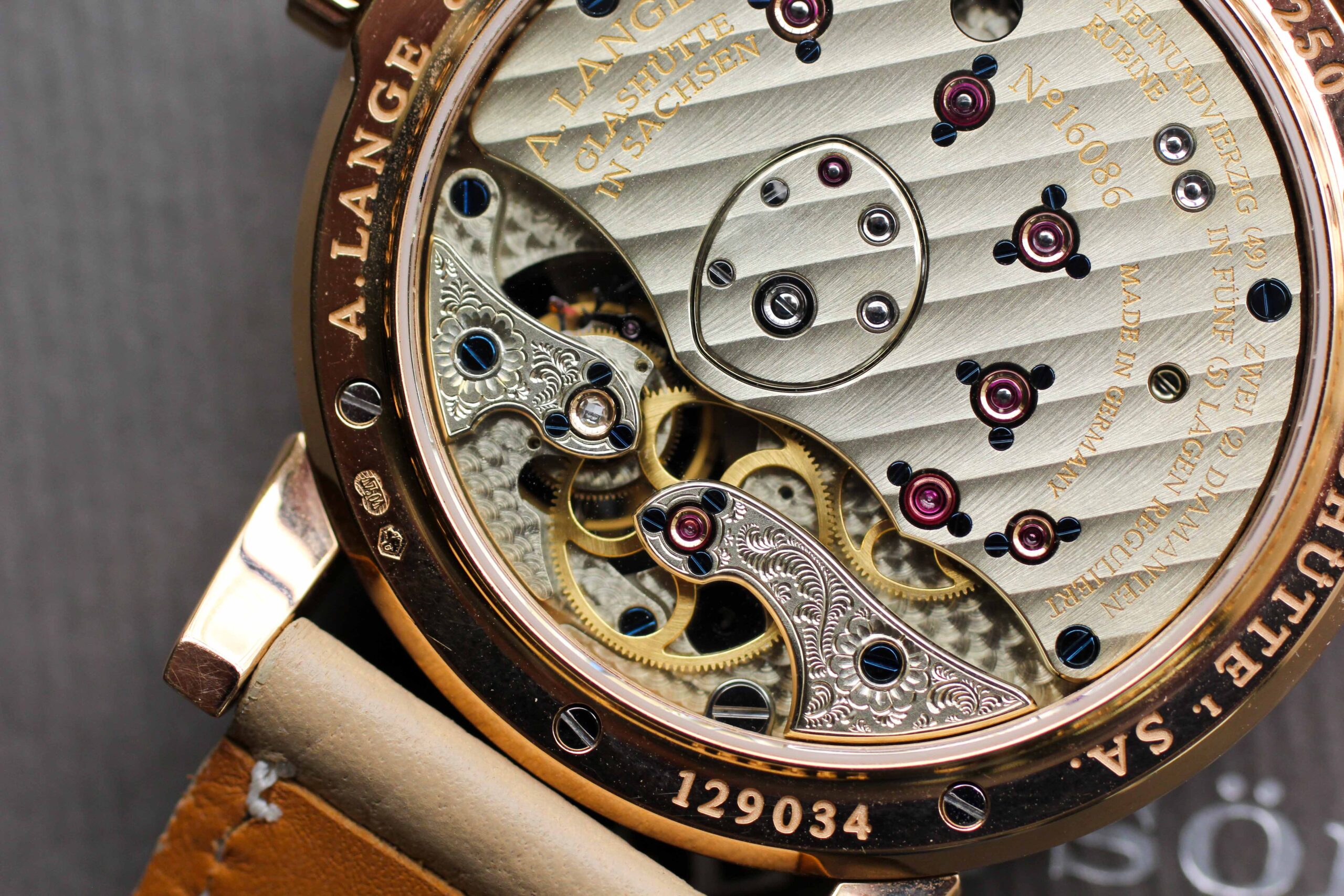
Understanding The Current Lange 1 Market (Winter 2023)
As noted above, prices had been consistently increasing for desirable Lange 1’s from 2020-2022, which was the cumulative effect of multiple market forces. One of the biggest collector trends since 2018 has been a move away from vintage sports watches and towards neo-vintage and modern watches from independents and prestige brands. On the independent side, this has been most prominent in Philippe Dufour, where desirable references of his watches have been pushed into seven-figure territory, and FP Journe, which has seen 5x+ value multiples for many references in just a five year stretch. There has also been a revived interest in 1980’s/90’s offerings from Patek Philippe, Vacheron Constantin, and Audemars Piguet, with a shift towards complications (i.e. perpetual calendars and chronographs).
Ultimately, the intensity of collector and speculative interest in FP Journe seemed to created a “spillover” effect into Lange beginning in 2020. Specifically within the Lange 1 range, this created a persistent upward trend for the most coveted references. Notwithstanding extremely rare iterations with hyper limited production runs (such as this steel 101.026, this boutique-only honey gold version, and this captivating Dubail limited edition), the top of the Lange 1 market is generally occupied by the Darth, blue dials, and early closed caseback models, which are still consistently selling for $50-75K+, despite a broader pullback in prices for many brands and references during late-2022 / early-2023.
The Lange 1 Tourbillon continues to be less well known than the references above, but the tides may soon be changing. One of the best performing lots at Phillips’ New York summer 2022 auction was this “Darth Tourbillon,” an exceptionally rare reference produced in just 20 pieces, that was purchased for $529K. In the wake of that result, a number of early tourbillons were sold during the winter auctions, with prices ranging from as low as $80K (an outlier, in my view) to $130K. Privately, I would estimate the current market (as of winter 2023) for the first series gold tourbillons to be $85-100K, with platinum examples commanding $100-120K. These price ranges represent strong increases from 2018/2019, but given the historical significance and limited production of the early references, I believe they still represent strong value and have been overlooked by many collectors to this point.

